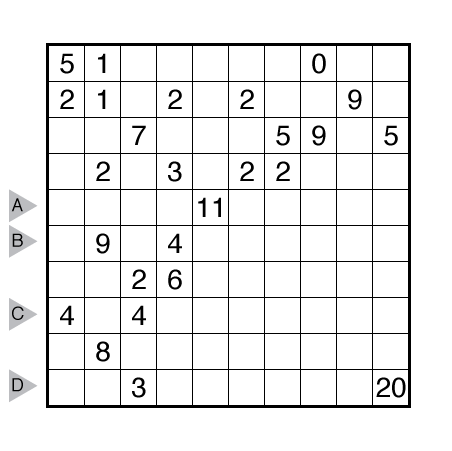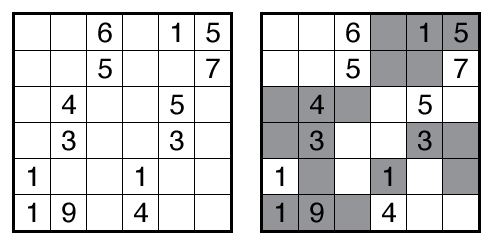Turf by John Bulten
(Note: puzzles during this bonus week are harder than usual; the four puzzles from Monday-Thursday are all about Thursday or Friday level difficulty.)

or solve online (using our beta test of Penpa-Edit tools).
Theme: Anchor
Author/Opus: This is the 42nd puzzle from our contributing puzzlemaster John Bulten.
Rules: Shade some white cells black so that one of the grid’s clues in each contiguous white or black region indicates the clued region’s area. (Each contiguous region must therefore have at least one clue.) Any other clue in the region must indicate how many of the clued cell’s immediate neighbors are white (up to 9, including itself).
Also see this example:

Answer String: Enter the length in cells of each of the black segments from left to right for the marked rows. Separate each row’s entry from the next with a comma.
Time Standards (highlight to view): Grandmaster = 3:45, Master = 6:15, Expert = 12:30
Solution: Answers for this week in this PDF.
Note: Turf is a shading puzzle created by John Bulten. We will have several more Turf puzzles from John in a few months when we start a new “Puzzlemasters’ Workshop” book series.

I have been struggling developing strategies to approach this puzzle with, to me the rules feel very open on how you can shade things, which is making it difficult for me to come up with strategies and rules to help shade in areas. I have made a small amount of progress in one area.
Does anyone have suggestions of other types of puzzles I could try to start developing strategies that may be similar to ones needed for this puzzle?
Thank you Kevin! Most important is Checkered Fillomino: https://www.gmpuzzles.com/blog/?s=checkered
I think there were other puzzles that use checkering logic, which is often very forcing, but they are not coming to mind. I also recommend Transparent puzzles and particularly Minesweeper, but what I’ve found for now is Linesweeper https://www.gmpuzzles.com/blog/2016/05/linesweeper-transparent-by-prasanna-seshadri/ and Minesweeper Battleships https://www.gmpuzzles.com/blog/2016/05/battleships-minesweeper-transparent-by-prasanna-seshadri/
Nurikabe skills are important this week and this is one of my favorite Nurikabe: https://www.gmpuzzles.com/blog/2014/07/nurikabe-tapio-saarinen/
Usually these solving paths involve excluding or narrowing down options, which could be whether a cell is white or black, or whether a clue is color or area. The shifting between several meanings of each clue is standard in TomTom and some other puzzles, and trying all meanings often narrows the path, especially when checkered logic is applied. In the example, some clues are obvious area clues because of their size; some adjoining clues are so disparate that they cannot both be color clues (as if in Minesweeper); some cells are automatically colored because borders of adjoining regions are set (important); and some cell color choices produce paths of colorations resulting in impossibility due to island area combined with border color rules.
And my last open secret for now is that each region has at least one clue (see rules), so new unclued regions must continue growing until they reach a clue. This is as in Light and Shadow (more about Serkan’s puzzle type later).
I see the 4 in the example’s bottom row not only is an area clue, but also happens to match the white-cell clue that would go there. Okay.
In a region with more than one number, can more than one (matching) clue be the area clue, even if none of them is a white-cell clue?
Hi Bryce,
At most one clue in a region can ONLY be an area clue. When there is one clue in a region, it is always an area clue and can be a white cell clue as well as in the example. When there are multiple clues in a region, at least n-1 of them must be valid as white cell clues. (This is indicated by the language “any other clue in the region …”.)
So in that lower-right region, it would be ok to have R6C4 and R6C5 both be 4’s (in this case either can count as the single area clue). It is ok to have R6C4 and R6C6 both be 4’s (in this case, R6C6 must be the area clue). It is NOT ok to have R5C5 and R6C6 both be 4’s as whichever clue you call the area clue, the other is not a valid white cell clue.
Hopefully this clarifies the rules for you.
Thanks John,
I will look at some of these, I have solved the other puzzles for the week that you created, with some effort. The final puzzle I have started working on filling in in various sections. But obviously without a strong grasp of Turf, it is difficult to work on.
The rules for this genre need some refinement based on my solving experience. The most important change I would suggest is using Fillomino type grids with dashed gridlines; I found myself marking a few boundaries where I knew two different regions touched, even though I might not have known which region was shaded at the time. This might just be the newness of the style; it could be that standard deductions don’t require tracking this kind of detail (like how in Slitherlink tracking the inside/outside of the loop is helpful but not usually required.) However, I could see a puzzle designed around tracking several touching regions without knowing which ones are shaded.
Another issue is more of a usability issue; the “Any other clue in the region must indicate how many of the clued cell’s immediate neighbors are white (up to 9, including itself)” rule make it so that for clue cells, you need to track two different properties: whether the clue is an area clue or a minesweeper-type clue, and whether it should be shaded, which makes it awkward to annotate. If the rule was changed to avoid referencing shading, say something like “Any other clue in the region must indicate how many of the clued cell’s immediate neighbors are part of the same region (up to 9, including itself)”, it would be more manageable.
Anyway, I hope this doesn’t sound too negative, I did enjoy solving this puzzle despite the issues I outlined. I hope this feedback will be useful for future puzzles in this style, it seems promising!
This was my favorite of the four types introduced this week — I enjoyed juggling the deductions of whether numbers had to be area clues or minesweeper clues, and to disagree with C’s suggestion above, I liked how the feel of the minesweeper clues changed depending on the shading of the regions they were in.
Now that’s a puzzle type I want to see more of! Very nice deductions, once you manage to get all the rules sorted 🙂